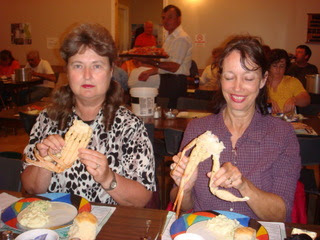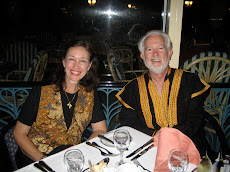
 We set out from Englishtown one day, only to have a flat tire (our first mishap of any kind, PTL!), which required the purchase of two new tires at the nearby Wal-Mart and forced us to delay our trip to Louisbourg until the next morning. But we finally got on our way and enjoyed a beautiful 1 1/2 hour drive across eastern Cape Breton. On the way we passed this Cape Breton fried chicken restaurant:
We set out from Englishtown one day, only to have a flat tire (our first mishap of any kind, PTL!), which required the purchase of two new tires at the nearby Wal-Mart and forced us to delay our trip to Louisbourg until the next morning. But we finally got on our way and enjoyed a beautiful 1 1/2 hour drive across eastern Cape Breton. On the way we passed this Cape Breton fried chicken restaurant: I'm assuming they got the idea for their catchy title from KFC's slogan, Finger-Lickin' Good, but I can't see the name taking off here in the US!
I'm assuming they got the idea for their catchy title from KFC's slogan, Finger-Lickin' Good, but I can't see the name taking off here in the US! The French were, and still are, a major force in the life of Cape Breton. The sad story of the Acadians is told by Longfellow in his epic poem, "Evangeline." But the French also had a major military interest in the area, and possessed, off and on, the Fortress Louisbourg. It is shown here across the bay from the modern town of Louisbourg and is the Cape Breton equivalent of our Colonial Williamsburg, Virginia. It is a National Historical Site and very interesting to visit.
The French were, and still are, a major force in the life of Cape Breton. The sad story of the Acadians is told by Longfellow in his epic poem, "Evangeline." But the French also had a major military interest in the area, and possessed, off and on, the Fortress Louisbourg. It is shown here across the bay from the modern town of Louisbourg and is the Cape Breton equivalent of our Colonial Williamsburg, Virginia. It is a National Historical Site and very interesting to visit. The visit begins with a walk through this gate, where one encounters cod fisherman working in their shop or on their nets. The king's bakery nearby provides loaves of "soldier's bread" which is pretty rough but good.
The visit begins with a walk through this gate, where one encounters cod fisherman working in their shop or on their nets. The king's bakery nearby provides loaves of "soldier's bread" which is pretty rough but good.  As you walk the streets you pass various vendors and soldiers going about their daily chores.
As you walk the streets you pass various vendors and soldiers going about their daily chores. 
 Several times a day the soldiers drill and march to the waterfront where they fire a musket volley and cannon. And each day a thief, the same thief,
Several times a day the soldiers drill and march to the waterfront where they fire a musket volley and cannon. And each day a thief, the same thief,  is publically disciplined for stealing a bottle of wine. (You'd think he'd learn, eh?)
is publically disciplined for stealing a bottle of wine. (You'd think he'd learn, eh?) Fortress Louisbourg is described as the largest restored fortress in North America.
Fortress Louisbourg is described as the largest restored fortress in North America.  On leaving Fortress Louisbourg at the end of the day, we stopped at a local restaurant for a sampling of...you guessed it...more lobster.
On leaving Fortress Louisbourg at the end of the day, we stopped at a local restaurant for a sampling of...you guessed it...more lobster. We haven't tired of it yet! Mmmmmm, good! Wish you were here!
We haven't tired of it yet! Mmmmmm, good! Wish you were here!Rog and Meg, Geri and Jon











































